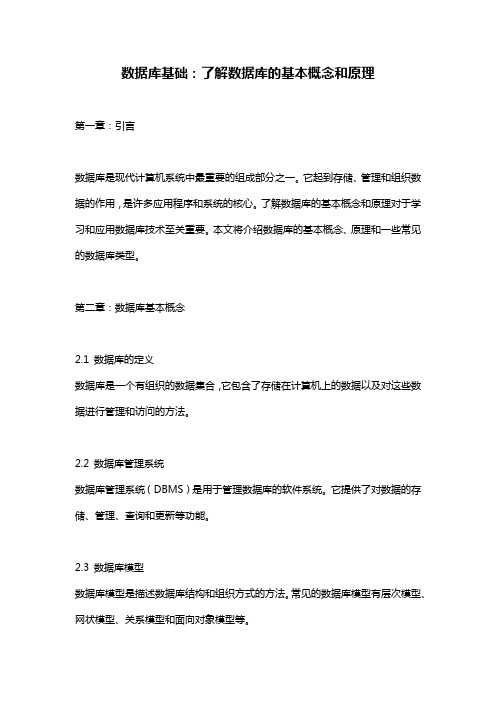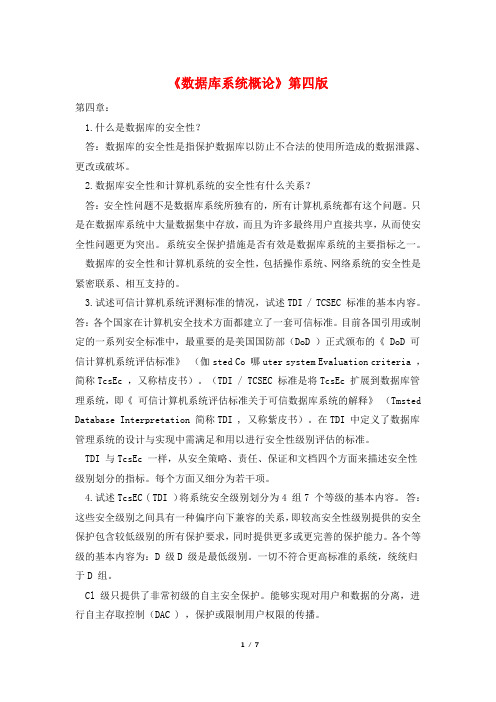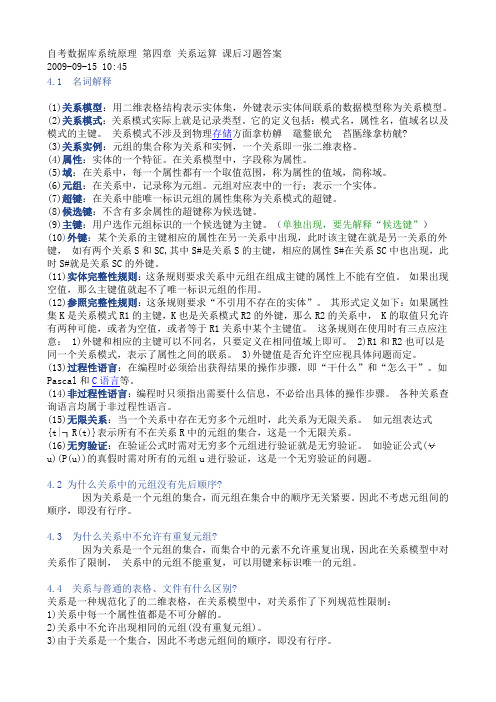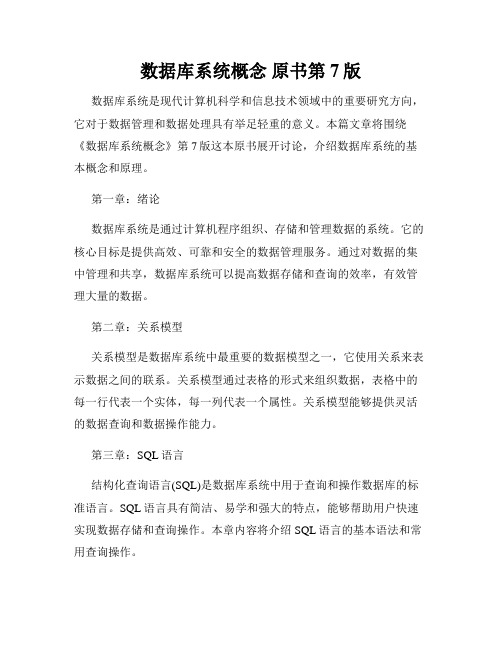数据库系统概念第四章
数据库原理与应用第四章

说明:
函数依赖不是指关系模式R的某个或某些关系实例满足的约束条件,而是指R的所有关系实例均要满足的约束条件。 函数依赖是语义范畴的概念。只能根据数据的语义来确定函数依赖。 例如“姓名→年龄”这个函数依赖只有在不允许有同名人的条件下成立 数据库设计者可以对现实世界作强制的规定。例如规定不允许同名人出现,函数依赖“姓名→年龄”成立。所插入的元组必须满足规定的函数依赖,若发现有同名人存在, 则拒绝装入该元组。
四、关系模式的简化表示
关系模式R(U, D, DOM, F) 简化为一个三元组: R(U, F) 当且仅当U上的一个关系r 满足F时,r称为关系模式 R(U, F)的一个关系
五、数据依赖对关系模式的影响
例:描述学校的数据库:
学生的学号(Sno)、所在系(Sdept) 系主任姓名(Mname)、课程名(Cname) 成绩(Grade) 单一的关系模式 : Student <U、F> U ={ Sno, Sdept, Mname, Cname, Grade }
汇报时间:12月20日
Annual Work Summary Report
一、概念回顾
关系:描述实体、属性、实体间的联系。 从形式上看,它是一张二维表,是所涉及属性的笛卡尔积的一个子集。 关系模式:用来定义关系。 关系数据库:基于关系模型的数据库,利用关系来描述现实世界。 从形式上看,它由一组关系组成。 关系数据库的模式:定义这组关系的关系模式的全体。
4.2.2 码
定义5.4 设K为关系模式R<U,F>中的属性或属性组合。若K f U,则K称为R的一个侯选码(Candidate Key)。若关系模式R有多个候选码,则选定其中的一个做为主码(Primary key)。 主属性与非主属性 ALL KEY
04735数据库系统原理(2021版)课后习题参考答案

04735数据库系统原理(2021版)课后习题参考答案答案仅供参考第一章数据库系统概述选择题B、B、A简答题1.请简述数据,数据库,数据库管理系统,数据库系统的概念。
P27数据是描绘事物的记录符号,是指用物理符号记录下来的,可以鉴别的信息。
数据库即存储数据的仓库,严格意义上是指长期存储在计算机中的有组织的、可共享的数据集合。
数据库管理系统是专门用于建立和管理数据库的一套软件,介于应用程序和操作系统之间。
数据库系统是指在计算机中引入数据库技术之后的系统,包括数据库、数据库管理系统及相关实用工具、应用程序、数据库管理员和用户。
2.请简述早数据库管理技术中,与人工管理、文件系统相比,数据库系统的优点。
数据共享性高数据冗余小易于保证数据一致性数据独立性高可以施行统一管理与控制减少了应用程序开发与维护的工作量3.请简述数据库系统的三级形式和两层映像的含义。
P31答:数据库的三级形式是指数据库系统是由形式、外形式和内形式三级工程的,对应了数据的三级抽象。
两层映像是指三级形式之间的映像关系,即外形式/形式映像和形式/内形式映像。
4.请简述关系模型与网状模型、层次模型的区别。
P35使用二维表构造表示实体及实体间的联络建立在严格的数学概念的根底上概念单一,统一用关系表示实体和实体之间的联络,数据构造简单明晰,用户易懂易用存取途径对用户透明,具有更高的数据独立性、更好的平安保密性。
第二章关系数据库选择题C、C、D简答题1.请简述关系数据库的根本特征。
P48答:关系数据库的根本特征是使用关系数据模型组织数据。
2.请简述什么是参照完好性约束。
P55答:参照完好性约束是指:假设属性或属性组F是根本关系R的外码,与根本关系S的主码K相对应,那么对于R中每个元组在F上的取值只允许有两种可能,要么是空值,要么与S中某个元组的主码值对应。
3.请简述关系标准化过程。
答:对于存在数据冗余、插入异常、删除异常问题的关系形式,应采取将一个关系形式分解为多个关系形式的方法进展处理。
数据库第四章——数据库安全性

输入密码
SQL Server 2005密码复杂性策略: 1. 不得包含全部或部分(>=3)用户帐号名; 2. 长度至少6个字符; 3. 密码包含4类字符:英文大写字母、小写 字母、10个基本数字,非字母字符(!@等)
19
An Introduction to Database System
5
An Introduction to Database System
数据的安全性是指保护数据以防止因不合法的使用而 数据的安全性是指保护数据以防止因不合法的使用而 造成数据的泄露、更改和破坏。 造成数据的泄露、更改和破坏。这就要采取一定的安 全措施。 全措施。 数据库的安全性和计算机系统的安全性,包括计算机 数据库的安全性和计算机系统的安全性, 硬件、操作系统、网络系统等的安全性,是紧密联系、 硬件、操作系统、网络系统等的安全性,是紧密联系、 相互支持的。 相互支持的。
输入用户名 kk
输入密码
SQL Server 2000密码复杂性策略: 2000密码复杂性策略 密码复杂性策略: 1. 不得包含全部或部分(>=3)用户帐号名; 不得包含全部或部分(>=3)用户帐号名; 2. 长度至少6个字符; 长度至少6个字符; 3. 密码包含4类字符:英文大写字母、小写 密码包含4类字符:英文大写字母、 字母、10个基本数字 非字母字符(! 个基本数字, (!@ 字母、10个基本数字,非字母字符(!@等)
14
An Introduction to Database System
删除Windows NT认证模式登录账号
步骤如下: 步骤如下: 以系统管理员身份进入企业管理器,并展开目录树; (1) 以系统管理员身份进入企业管理器,并展开目录树; 在目录树的“登录名” 节点下, (2) 在目录树的“登录名” 节点下,选中待删除的名称 wfy\wfytest” “wfy\wfytest”
数据库系统基础教程课后答案第四章

4.2.7 In below figure there exists a many-to-one relationship between Babies and Births and another many-to-one relationship between Births and Mothers. From transitivity of relationships, there is a many-to-one relationship between Babies and Mothers. Hence a baby has a unique mother while a birth can allow more than one baby.
4.1.7
4.1.8 a)
(b)
4.1.9
Assumptions A Professor only works in at most one department. A course has at most one TA. A course is only taught by one professor and offered by one department. Students and professors have been assigned unique email ids. A course is uniquely identified by the course no, section no, and semester (e.g. cs157-3 spring 09).
4.2.4 The entity sets should have single attribute. a) Stars: starName b) Movies: movieName c) Studios: studioName. However there exists a many-to-many relationship between Studios and Contracts. Hence, in addition, we need more information about studios involved. If a contract always involves two studios, two attributes such as producingStudio and starStudio can replace the Studios entity set. If a contact can be associated with at most five studios, it may be possible to replace the Studios entity set by five attributes viz. studio1, studio2, studio3, studio4, and studio5. Alternately, a composite attribute containing concatenation of all studio names in a contact can be considered. A separator character such as "$" can be used. SQL allows searching of such an attribute using query like '%keyword%'
数据库基础:了解数据库的基本概念和原理

数据库基础:了解数据库的基本概念和原理第一章:引言数据库是现代计算机系统中最重要的组成部分之一。
它起到存储、管理和组织数据的作用,是许多应用程序和系统的核心。
了解数据库的基本概念和原理对于学习和应用数据库技术至关重要。
本文将介绍数据库的基本概念、原理和一些常见的数据库类型。
第二章:数据库基本概念2.1 数据库的定义数据库是一个有组织的数据集合,它包含了存储在计算机上的数据以及对这些数据进行管理和访问的方法。
2.2 数据库管理系统数据库管理系统(DBMS)是用于管理数据库的软件系统。
它提供了对数据的存储、管理、查询和更新等功能。
2.3 数据库模型数据库模型是描述数据库结构和组织方式的方法。
常见的数据库模型有层次模型、网状模型、关系模型和面向对象模型等。
2.4 数据库语言数据库语言是用于与数据库进行交互的语言。
常见的数据库语言有结构化查询语言(SQL)和数据库编程语言(如PL/SQL、T-SQL等)。
第三章:数据库原理3.1 数据库的组成数据库由数据、数据结构、数据操作和数据完整性约束等组成。
数据是数据库中存储的信息,数据结构是数据的组织方式,数据操作是对数据的增删改查操作,数据完整性约束是保证数据的一致性和有效性的规则。
3.2 数据库的存储方式数据库的存储方式包括文件存储和表格存储。
文件存储是将数据以文件的形式存储在磁盘上,表格存储是将数据以表格的形式存储在数据库中。
3.3 数据库的索引数据库的索引是用于快速查找数据的数据结构。
索引可以提高数据的查询效率,常见的索引结构有B树和哈希索引等。
3.4 数据库的事务管理数据库的事务是指一组数据库操作的逻辑单元。
数据库管理系统通过事务管理机制来保证数据库操作的原子性、一致性、隔离性和持久性。
第四章:常见的数据库类型4.1 关系型数据库关系型数据库是以关系模型为基础的数据库。
它使用表格来组织和管理数据,表格中的数据通过主键和外键进行关联。
4.2 非关系型数据库非关系型数据库是一种不使用关系模型的数据库。
数据库复习总结

数据库复习总结本页仅作为文档封面,使用时可以删除This document is for reference only-rar21year.March第一章数据库系统概论1.试述数据、数据库、数据库系统、数据库管理系统的概念。
数据:描述事物的符号记录称为数据。
数据的种类有文字、图形、图象、声音、正文等等。
数据与其语义是不可分的。
数据库:数据库是长期储存在计算机内、有组织的、可共享的数据集合。
数据库中的数据按一定的数据模型组织、描述和储存,具有较小的冗余度、较高的数据独立性和易扩展性,并可为各种用户共享。
数据库系统:数据库系统(DBS)是指在计算机系统中引入数据库后的系统构成。
数据库系统由数据库、数据库管理系统(及其开发工具)、应用系统、数据库管理员构成。
数据库管理系统:数据库管理系统(DBMS)是位于用户与操作系统之间的一层数据管理软件。
用于科学地组织和存储数据、高效地获取和维护数据。
DBMS 主要功能包括数据定义功能、数据操纵功能、数据库的运行管理功能、数据库的建立和维护功能。
2.什么是数据独立性数据独立性又分为哪两个层次为什么需要数据独立性数据独立性是用来描述数据与应用程序之间的依赖程度,包括数据的物理独立性和数据的逻辑独立性,依赖程度越低则独立性越高物理独立性是指用户的应用程序与存储在磁盘上的数据库的数据时相互独立的。
逻辑独立性是指用户的应用程序与数据库的逻辑结构是相互独立的。
作用:数据在磁盘上怎样存储由DBMS管理,用户程序不需要了解,应用程序要处理的只是数据的逻辑结构,这样当数据的物理存储改变了,应用程序不用改变。
数据独立性是通过数据库管理系统的两层映像功能来实现3.什么是数据模型数据模型的基本要素有哪些为什么需要数据模型数据模型是描述数据语义、数据与数据之间联系(数据结构)、数据操作,以及一致性约束的概念和工具的集合数据模型的基本要素:①数据结构:是所研究的对象类型的集合,是对系统的静态特性的描述。
《数据库系统概论》第四版

《数据库系统概论》第四版第四章:1.什么是数据库的安全性?答:数据库的安全性是指保护数据库以防止不合法的使用所造成的数据泄露、更改或破坏。
2.数据库安全性和计算机系统的安全性有什么关系?答:安全性问题不是数据库系统所独有的,所有计算机系统都有这个问题。
只是在数据库系统中大量数据集中存放,而且为许多最终用户直接共享,从而使安全性问题更为突出。
系统安全保护措施是否有效是数据库系统的主要指标之一。
数据库的安全性和计算机系统的安全性,包括操作系统、网络系统的安全性是紧密联系、相互支持的。
3.试述可信计算机系统评测标准的情况,试述TDI / TCSEC 标准的基本内容。
答:各个国家在计算机安全技术方面都建立了一套可信标准。
目前各国引用或制定的一系列安全标准中,最重要的是美国国防部(DoD )正式颁布的《 DoD 可信计算机系统评估标准》(伽sted Co 哪uter system Evaluation criteria ,简称TcsEc ,又称桔皮书)。
(TDI / TCSEC 标准是将TcsEc 扩展到数据库管理系统,即《可信计算机系统评估标准关于可信数据库系统的解释》(Tmsted Database Interpretation 简称TDI , 又称紫皮书)。
在TDI 中定义了数据库管理系统的设计与实现中需满足和用以进行安全性级别评估的标准。
TDI 与TcsEc 一样,从安全策略、责任、保证和文档四个方面来描述安全性级别划分的指标。
每个方面又细分为若干项。
4.试述TcsEC ( TDI )将系统安全级别划分为4 组7 个等级的基本内容。
答:这些安全级别之间具有一种偏序向下兼容的关系,即较高安全性级别提供的安全保护包含较低级别的所有保护要求,同时提供更多或更完善的保护能力。
各个等级的基本内容为:D 级D 级是最低级别。
一切不符合更高标准的系统,统统归于D 组。
Cl 级只提供了非常初级的自主安全保护。
能够实现对用户和数据的分离,进行自主存取控制(DAC ) ,保护或限制用户权限的传播。
第四章全局查询处理和优化

查询处理概述
查询处理问题
集中查询处理器必须:
将演算查询转换为代数操作 选择最好的执行计划
例如:
SELECT ENAME FROM E,G WHERE RESP = “Manager” and E.ENO=G.ENO
第四章 分布查询处理和优化
查询处理概述
关系代数 1: ( RESP " M anager " E . EM O G . EN O ( E G )) EN AM E
查询优化的基础
• 读取自然连接结果, 执行选择运算, 需50s, 选择结果均可放 在内存 • 投影运算: • 总花费为: 105+50+50=205s 3.4分钟 Q3= sname( Students Cno=„2‟(SC))
Q3代价计算(仅考虑I/O代价)
计算对SC做选择运算的代价 • 需读SC到内存进行选择运算 • 读SC块数为: 10000/100=100 • 花费为: 100/20=5s • 选择结果为50个SC元组, 均可放在内存
域演算:{ x 1 , x 2 , . . . x n | F ( x 1 , x 2 , . . . , x n )} 其中 x‟s: 域变量, F(x1,…,xn): wff 例如: { x , y | E ( x , y , " manager
" )}
第四章 分布查询处理和优化
查询处理概述
第四章 分布查询处理和优化
第四章 分布查询处理和优化
查询处理概述
优化的查询
G 1 ' RESP
E1 '
" Manager "
( G 1)
自考数据库系统原理 第四章 关系运算 课后习题答案

自考数据库系统原理第四章关系运算课后习题答案2009-09-15 10:454.1 名词解释(1)关系模型:用二维表格结构表示实体集,外键表示实体间联系的数据模型称为关系模型。
(2)关系模式:关系模式实际上就是记录类型。
它的定义包括:模式名,属性名,值域名以及模式的主键。
关系模式不涉及到物理存储方面拿枋觯 鼋鍪嵌允 萏匦缘拿枋觥?(3)关系实例:元组的集合称为关系和实例,一个关系即一张二维表格。
(4)属性:实体的一个特征。
在关系模型中,字段称为属性。
(5)域:在关系中,每一个属性都有一个取值范围,称为属性的值域,简称域。
(6)元组:在关系中,记录称为元组。
元组对应表中的一行;表示一个实体。
(7)超键:在关系中能唯一标识元组的属性集称为关系模式的超键。
(8)候选键:不含有多余属性的超键称为候选键。
(9)主键:用户选作元组标识的一个候选键为主键。
(单独出现,要先解释“候选键”)(10)外键:某个关系的主键相应的属性在另一关系中出现,此时该主键在就是另一关系的外键,如有两个关系S和SC,其中S#是关系S的主键,相应的属性S#在关系SC中也出现,此时S#就是关系SC的外键。
(11)实体完整性规则:这条规则要求关系中元组在组成主键的属性上不能有空值。
如果出现空值,那么主键值就起不了唯一标识元组的作用。
(12)参照完整性规则:这条规则要求“不引用不存在的实体”。
其形式定义如下:如果属性集K是关系模式R1的主键,K也是关系模式R2的外键,那么R2的关系中, K的取值只允许有两种可能,或者为空值,或者等于R1关系中某个主键值。
这条规则在使用时有三点应注意: 1)外键和相应的主键可以不同名,只要定义在相同值域上即可。
2)R1和R2也可以是同一个关系模式,表示了属性之间的联系。
3)外键值是否允许空应视具体问题而定。
(13)过程性语言:在编程时必须给出获得结果的操作步骤,即“干什么”和“怎么干”。
如Pascal和C语言等。
第四章 空间数据库

4 点-线查询 查询某点实体一定范围内的线实体。步骤
: (1)激活点图层,选择一个点
本次您浏览到是第三十二页,共四十三页。
(2)SQL查询 激活线图层,输入查询条件
本次您浏览到是第三十三页,共四十三页。
5 线-线查询
查询与某个线实体相连的其他线实体。步骤:
(1)激活线图层,选择一条线
本次您浏览到是第三十四页,共四十三页。
本次您浏览到是第十三页,共四十三页。
本次您浏览到是第十四页,共四十三页。
网状模型用连接指令或指针来确定数据间的显 式连接关系,是具有多对多类型的数据组织方 式 。网络模型将数据组织成有向图结构,结构 中结点代表数据记录,连线描述不同结点数据间 的关系。
存在以下问题:1)结构复杂,增加了用户查询 和定位的困难。要求用户熟悉数据的逻辑结构, 知道自身所处的位置。(2)网状数据操作命令 具有过程式性质(3)不直接支持对于层次结构 的表达。
(2)SQL查询
输入查条件
本次您浏览到是第三十五页,共四十三页。
6 面-线查询 查询经过某个面实体的线实体。步骤:
(1)激活面图层,选择一个面
本次您浏览到是第三十六页,共四十三页。
(2)SQL查询 激活线图层,输入查询条件
本次您浏览到是第三十七页,共四十三页。
7 点-面查询
查询某个点实体被包含在哪个面实体内部。 步骤: (1)激活点图层,选择一个点
本次您浏览到是第二十四页,共四十三页。
点、线、面实体相互关系的9种查询: 1 点-点查询
查询某点实体给定距离范围内的其他点 实体。如200km。步骤: (1)激活点图层,选择一个点
本次您浏览到是第二十五页,共四十三页。
(2)SQL查询(200km以内的其他点)
第四章-空间数据库

x
26.7 28.4 46.1 31.3 68.4
y
23.5 46.5 42.5 45.6 38.7
地 图
M
Ⅰ
Ⅱ
2 a 1
b Ⅰ d c 4
3
e Ⅱ g
5 f
M
多 形 边
Ⅰ Ⅱ
点
a c b e c f d g
1 2 3 4
x1 x2 x3 x4 x5 x6
y1 y2 y3 y4 t5 y6
学校名称 西北大学
系名 教师数 学生数 研究生 系名 教师数 学生数 研究生 城资系 系名 52 教师数 300 学生数 70 研究生 49 257 71 地质系 化学系
学号 姓名 年级 籍贯 系名 教师数 学生数 002312 系名 张三 教师数 3 学生数广东 研究生
教师号 姓名 年龄 职称 系名 教师数 学生数 66 系名 李四 教师数 30 学生数教授 研究生
数据库技术是20世纪 年代初开始发展起来的一 数据库技术是 世纪60年代初开始发展起来的一 世纪 门数据管理自动化的综合性新技术。 门数据管理自动化的综合性新技术。 一、数据库 数据库: 为了一定的目的 , 在计算机系统中以特定的 数据库 : 为了一定的目的, 结构组织、存储和应用的相关联的数据集合。 结构组织、存储和应用的相关联的数据集合。 空间数据库: 即地理信息系统的数据库, 空间数据库 : 即地理信息系统的数据库 , 是某区域内 关于一定地理要素特征的数据集合。 关于一定地理要素特征的数据集合。
1、计算机对数据的管理阶段
经过了三个阶段 : 程序管理阶段 文件管理阶段 数据库管理阶段
(1)程序管理阶段 变量赋值、运算、输出均在一个程序中进行,值变程 序就变。 如:add.c #include “stdio.h” main() { int a,b,c; a=3; b=5; c=a+b; printf(“c=%d\n”,c); } 编译后生成add.exe。
数据库系统概念 原书第7版

数据库系统概念原书第7版数据库系统是现代计算机科学和信息技术领域中的重要研究方向,它对于数据管理和数据处理具有举足轻重的意义。
本篇文章将围绕《数据库系统概念》第7版这本原书展开讨论,介绍数据库系统的基本概念和原理。
第一章:绪论数据库系统是通过计算机程序组织、存储和管理数据的系统。
它的核心目标是提供高效、可靠和安全的数据管理服务。
通过对数据的集中管理和共享,数据库系统可以提高数据存储和查询的效率,有效管理大量的数据。
第二章:关系模型关系模型是数据库系统中最重要的数据模型之一,它使用关系来表示数据之间的联系。
关系模型通过表格的形式来组织数据,表格中的每一行代表一个实体,每一列代表一个属性。
关系模型能够提供灵活的数据查询和数据操作能力。
第三章:SQL语言结构化查询语言(SQL)是数据库系统中用于查询和操作数据库的标准语言。
SQL语言具有简洁、易学和强大的特点,能够帮助用户快速实现数据存储和查询操作。
本章内容将介绍SQL语言的基本语法和常用查询操作。
第四章:关系数据库设计关系数据库设计是数据库系统中一个关键的环节,它涉及到数据库的结构设计和数据模型设计。
合理的数据库设计可以提高数据存储和查询的效率,减少数据冗余和数据不一致的问题。
本章内容将介绍关系数据库设计的基本原理和方法。
第五章:高级关系数据库设计高级关系数据库设计是在关系数据库设计的基础上进一步优化和完善数据库的设计。
它包括了主键和外键的设计、索引的设计以及数据库规范化等内容。
通过高级关系数据库设计,可以提高数据库的性能和可靠性。
第六章:数据仓库与数据挖掘数据仓库和数据挖掘是数据库系统中的重要技术,用于从大量的数据中挖掘有价值的信息。
数据仓库是一个面向主题的、集成的和稳定的数据集合,数据挖掘是从数据仓库中发现隐藏在数据中的模式和规律。
本章内容将介绍数据仓库和数据挖掘的基本概念和方法。
第七章:NoSQL数据库NoSQL数据库是一种非关系型的数据库系统,它能够有效地处理大规模和高速增长的数据。
数据库系统概论:第4章 关系数据库标准语言——SQL语言1

4)删除完整性约束
例:删除“Height”属性列上的CHECK约束。 ALTER TABLE Student DROP
CONSTRAINT Chk1;
27
5)删除属性列
例:删除Student表中新增加的“Height”属性列。 ALTER TABLE Student DROP COLUMN Height;
2
2、SQL语言应用情况
(1) Oracle、Sybase、Informix、Ingres、 DB2、SQL Server、Rdb等大型数据库管理系统 实现了SQL语言; (2) Dbase、Foxpro、Acess等PC机数据库管理 系统部分实现了SQL语言; (3)可以在HTML(Hypertext Markup Language, 超文本标记语言)中嵌入SQL语句,通过WWW访 问数据库; (4)在VC、VB、Delphi、PB也可嵌入SQL语句。
/*外键约束*/ Credit NUMBER);
21
例3:建立一个学生选课表SC,所有约束条件均为表
级完整性约束。
CREATE TABLE SC
( Sno CHAR(8),
Cno CHAR(8),
Grade NUMBER,
PRIMARY KEY(Sno,Cno),
/*主键约束*/
FOREIGN KEY(Sno) REFERENCES Student(Sno)
25
3)增加完整性约束
例:给Student表中“Height”属性列增加一 个CHECK约束,要求学生的身高要超过140厘 米才行。 ALTER TABLE Student ADD CONSTRAINT Chk1 CHECK(Height>140);
数据库课件 第四章 结构化查询语言

4.2.2 基本表的修改
【例4.4】向抢修工程计划表salvaging增加‚工程项目负 责人‛列,数据类型为字符型。
注意:不论基本表中原来是否已有数据,新增加的列一律为空值。
4.3 数据查询
执行过程:
(1)读取FROM子句中基本表、视图的数据,执行笛卡 儿积操作;
(2)选取满足WHERE子句中给出的条件表达式的元组; (3)按GROUP子句中指定列的值分组,同时提取满足 HAVING子句中组条件表达式的那些组;
(4)按SELECT子句中给出的列名或列表达式求值输出;
(5)ORDER子句对输出的目标表进行排序,可选择升序 或降序.
• 结果集
– 查询操作的对象是关系,结果还是一个关系, 是一个结果集,而且是一个动态数据集。
4.3 数据查询
我们以电力抢修工程数据库 为例说明SELECT语 句的各种用法.
(a) stock表
4.3 数据查询
(b) salvaging表
4.3 数据Βιβλιοθήκη 询(c) out_stock表
4.3.1 单表查询
4.2.1 基本表的定义
(3)配电物资领料出库表: out_stock(prj_num, mat_num, amount, get_date, department) 主码为(prj_num, mat_num) 各属性含义如下: 工程项目编号(prj_num) 物资编号(mat_num) 领取数量(amount) 领料日期(get_date) 领料部门(department)
4.2.1 基本表的定义
ch4 数据库系统概念(第6版)第四章中间SQL

FOREIGN KEY 约束控制列中数值相似。区别在于它们如何判断哪些 值有效:FOREIGN KEY 约束从另一个表中获得有效数值列表, CHECK 约束从逻辑表达式判断而非基于其它列的数据。例如,通过 创建 CHECK 约束可将 salary 列的取值范围限制在 $15,000 至 $100,000 之间,从而防止输入的薪金值超出正常的薪金范围。
check子句 域约束(续)
CREATE TABLE cust_sample ( cust_id int PRIMARY KEY, cust_name char(50), cust_address char(50), cust_credit_limit money, CONSTRAINT chk_id CHECK (cust_id BETWEEN 0 and 10000 ) )
name varchar(20) not null budget numeric(12,2) not null
unique ( A1, A2, …, Am)
唯一性声明表明了属性A1, A2, … Am构成一个候选码. 候选码允许空值 (主码则不允许).
check子句 域约束
问题 完整性约束通过授权 用户对数据库修改时,保证不会损坏 数据库的一致性。 域约束是完整性约束最基本的形式,它会测试插入数据库 的值。 CHECK 约束 (在SQL-92中 check 允许域受约束)
连接关系 - 范例
course natural right outer join prereq
course full outer join prereq using (course_id)
视图
数据库系统原理与设计(万常选版)第四章练习题和详细答案

数据库系统原理与设计(万常选版)第四章练习题和详细答案第四章关系系统及其优化一、选择题1.概念模型是现实世界的第一层抽象,这一类最著名的模型是()。
A.层次模型B. 关系模型C. 网状模型D. 实体-关系模型2.区分不同实体的依据是()。
A. 名称B. 属性C. 对象D. 概念3.关系数据模型是目前最重要的一种数据模型,它的三个要素分别为()。
A.实体完整、参照完整、用户自定义完整B.数据结构、关系操作、完整性约束C.数据增加、数据修改、数据查询D.外模式、模式、内模式4.在()中一个结点可以有多个双亲,节点之间可以有多种联系。
A.网状模型B. 关系模型C.层次模型D. 以上都有5.()的存取路径对用户透明,从而具有更高的数据独立性、更好的安全保密性,也简化了程序员的工作和数据库开发建立的工作。
A.网状模型B. 关系模型D.层次模型 D. 以上都有6.在关系数据库中,要求基本关系中所有的主属性上不能有空值,其遵守的约束规则是()。
A.数据依赖完整性规则B. 用户定义完整性规则C.实体完整性规则D. 域完整性规则选择题答案:二、简答题1.试述关系模型的三个组成部分。
答:关系模型由关系数据结构、关系操作集合和关系完整性约束三部分组成。
2.试述关系数据语言的特点和分类。
答:关系数据语言可以分为三类:关系代数语言例如ISBL关系演算语言(元组关系演算语言例如APLHA,QUEL 和域关系演算语言例如QBE)具有关系代数和关系演算双重特点的语言例如SQL这些关系数据语言的共同特点是,具有完备的表达能力,是非过程化的集合操作语言,功能强,能够嵌入高级语言中使用。
3. 定义并理解下列术语,说明它们之间的联系与区别:(1)域,关系,元组,属性答:域:域是一组具有相同数据类型的值的集合。
关系:在域D1,D2,…,Dn上笛卡尔积D1×D2×…×Dn的子集称为关系,表示为R(D1,D2,…,Dn)元组:关系中的每个元素是关系中的元组。
- 1、下载文档前请自行甄别文档内容的完整性,平台不提供额外的编辑、内容补充、找答案等附加服务。
- 2、"仅部分预览"的文档,不可在线预览部分如存在完整性等问题,可反馈申请退款(可完整预览的文档不适用该条件!)。
- 3、如文档侵犯您的权益,请联系客服反馈,我们会尽快为您处理(人工客服工作时间:9:00-18:30)。
Uses null values.
SSDUT-Software School of DUT
Left Outer Join
select * from student natural left outer join takes;
The left outer join preserves tuples only in the relation named before (to the left of) the left outer join operation.
SSDUT-Software School of DUT
Join Expressions
SSDUT-Software School of DUT
SSDUT-Software School of DUT
Review Join and Natural Join
– select *
from student, takes where student.ID = takes.ID;
SSDUT-Software School of DUT
Full Outer Join
The full outer join preserves tuples in both relations.
Display a list of all students in the Comp. Sci. department, along with the course sections, if any, that they have taken in Spring 2009; all course sections from Spring 2009 must be displayed, even if no student from the Comp. Sci. department has taken the course section.
select * from (select * from student where dept name= ‟Comp. Sci‟) natural full outer join (select * from takes where semester = ‟Spring‟ and year = 2009);
SSDUT-Software School of DUT
Join Conditions
select * from student join takes on student.ID=takes.ID;
select * from student, takes where student.ID = takes.ID;
SSDUT-Software School of DUT
Joined Relations
The default join type, when the join clause is used without the outer prefix is the inner join. select * from student join takes on student.ID=takes.ID
SSDUT-Software School of DUT
Outer Joins
Observe that student Snow, with ID 70557, has not taken any courses
SSDUT-Software School of DUT
Outer Joins
An extension of the join operation that avoids loss of information. (避免信息丢失) Computes the join and then adds tuples form one relation that does not match tuples in the other relation to the result of the join. (首先进行连接,之后加入一
select ID, name, dept_name from instructor
Any disadvantages?
SSDUT-Software School of DUT
Views
A view provides a mechanism to hide certain data from the view of certain users. Any relation that is not of the conceptual model but is made visible to a user as a “virtual relation” is called a view.(不是概念模型
select * from student left outer join takes on true where student.ID= takes.ID;
SSDUT-Software School of DUT
Joined Relations
Join operations take two relations and return as a result another relation. These additional operations are typically used as subquery expressions in the from clause Join condition (连接条件)– defines which tuples in the two relations match, and what attributes are present in the result of the join. Join type(连接类型) – defines how tuples in each relation that do not match any tuple in the other relation (based on the join condition) are treated.
– select ID
from student left outer join takes on student.ID=takes.ID where course_id is null;
SSDUT-Software School of DUT
Comparison
select * from student left outer join takes on student.ID= takes.ID;
Good reasons for introducing the on condition:
– an SQL query is often more readable if the join condition is
specified in the on clause and the rest of the conditions appear in the where clause – In outer join, on conditions do behave in a manner different from where conditre School of DUT
Right Outer Join
select * from takes right outer join student on student.ID=takes.ID
The right outer join preserves tuples only in the relation named after (to the right of) the right outer join operation.
select * from student inner join takes on student.ID=takes.ID;
SSDUT-Software School of DUT
Try…
Find the information of all courses, along with their prerequisite course ID.
SSDUT-Software School of DUT
Try…
Find the information of all courses, along with their prerequisite course ID.
– select *
from course left outer join prereq on course.course_id=prereq.course_id
SSDUT-Software School of DUT
Try…
For all students, find their ID, name, dept name, and tot_cred, along with the courses that they have taken.
Incorrect version select * from student, takes where student.ID = takes.ID;
– select *
from student natural join takes;
– select *
from student join takes using (ID);
SSDUT-Software School of DUT
Join Conditions
SQL supports another form of join, in which
– Integrity (完整性) (included in DDL)
